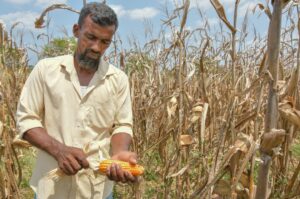Physical Address
23,24,25 & 26, 2nd Floor, Software Technology Park India, Opp: Garware Stadium,MIDC, Chikalthana, Aurangabad, Maharashtra – 431001 India
Physical Address
23,24,25 & 26, 2nd Floor, Software Technology Park India, Opp: Garware Stadium,MIDC, Chikalthana, Aurangabad, Maharashtra – 431001 India

Agriculture predominantly depends on climate conditions and natural resources. Thus, climate change decisively impacts agriculture-based economies such as Sri Lanka. The FAO 2016 had noted that climate change has prolonged impacts on agriculture and food security. A 60% increase in global food demand is expected to occur by 2050 as compared to the levels seen in 2006.
Food security has four dimensions: availability, accessibility, utilization and stability. Impediments in any of these dimensions would challenge food security at all levels, from individual to global scale. As per the definition, ‘food security‘ exists when all people, at all times, have physical and economic access to sufficient, safe and nutritious food that meets their dietary needs and food preferences for an active and healthy life. Read more about this here Archived.
WFP (World Food Program)has mentioned that at present, around 690 million people all over the World would go to bed on an empty stomach. Therefore, global attention is on getting rid of this situation under the concept of saving and changing lives. As a result, donations of food for those in need all around the World. More on this here | Archived.
According to WFP, 6.3 million people in Sri Lanka are “food insecure” and require humanitarian assistance. Among these, around 5.3 million people are either reducing or skipping meals. Furthermore, more than 60 per cent of families eat cheaper and less nutritious food. As a result, at least 65,600 people are severely food insecure.
This situation is likely to worsen as the island nation’s crisis unfolds. The contributing reasons may vary from high inflation, loss of livelihood, weak purchasing power, and acute shortage of essential items.
The food security of Sri Lanka is expected to deteriorate further without external assistance and mainly during October 2022 to February 2023 lean season, driven by a poor harvest of staple foods like rice.
The cost of staple food such as rice and vegetables has doubled. In addition, cooking gas is both expensive and in short supply, making it difficult for many to keep kitchen fires burning. WFP said skyrocketing food costs make it harder for the population to meet their food needs. The situation has further worsened as the Government has scaled down its nutrition programs due to severe financial constraints. This includes school meals and fortified food for mothers and malnourished children.
The Global Hunger Index (GHI) is a tool designed to comprehensively measure and track hunger at the global, regional, and national levels. Sri Lanka scored an all-time lowest in 2021 with 16.0 points showing a moderate hunger level.
Higher concentration of carbon dioxide causes the reduction of food nutritional quality. For example, recent research has shown that with highly elevated atmospheric carbon dioxide (CO2) concentrations, iron and zinc content in plants could fall by as much as 17 per cent, resulting in increased starch and sugar production in plants. This shift in nutritional quality could cause an additional 175 million people to experience zinc deficiency and 122 million to experience protein deficiency. According to researchers, nourishment issues already cost the global economy $3.5 trillion, ending in lost opportunity and human capital. Read more about this here Archived.
Severe drought followed by heavy rainfalls in Sri Lanka has hit large swaths of cropping areas, threatening the food security of some 900,000 people, according to FAO and WFP. Other crops, including pulses, chillies and onions, which rely mainly on rainwater, were also heavily damaged by dry weather.
Rainfall variability is critical for crop cultivation as cropping seasons depend on rainfall patterns. Inter-decadal variability of rainfall has increased over the recent decades compared to the past. Rainfall data for the last 30 years show high spatial and temporal variations with negative and positive trends. Delays in the onset of rainfall and changes in the distribution of rain have caused disruptions to the regular crop calendar, frequent crop failure, and loss of yield. More can be read from here, Archived.
Severe climate events have increased in recent decades, resulting in adverse effects on food production, especially rice production, resulting in the need to import significant quantities of rice to meet national requirements.
Increasing temperature will increase evapotranspiration rates and losses, resulting in greater soil moisture deficits and temporal evolution of soil salinity in upland cropping systems. Moreover, rising ambient temperatures could increase the field heat and respiration rates of perishable horticultural products, thereby increasing post-harvest losses and storage costs. More can be read from here, Archived.
The World’s leading plant health and biosecurity authorities came together for the World’s first-ever International Plant Health Conference (IPHC). This was co-organized by FAO, the Secretariat of the International Plant Protection Convention (IPPC) and Defra.
More than 500 policymakers, academics and experts from over 74 countries gathered to address current and future plant health challenges. This includes the impacts of climate change, food security, environmental protection, facilitating safe trade, and new pest and disease pathways. The event was held from the 21st to the 23rd of September. The delegates shared knowledge and discussed global scientific, technical and regulatory issues alongside actions to tackle these existential threats to our society, economy and environment. Read more about this here. Archived